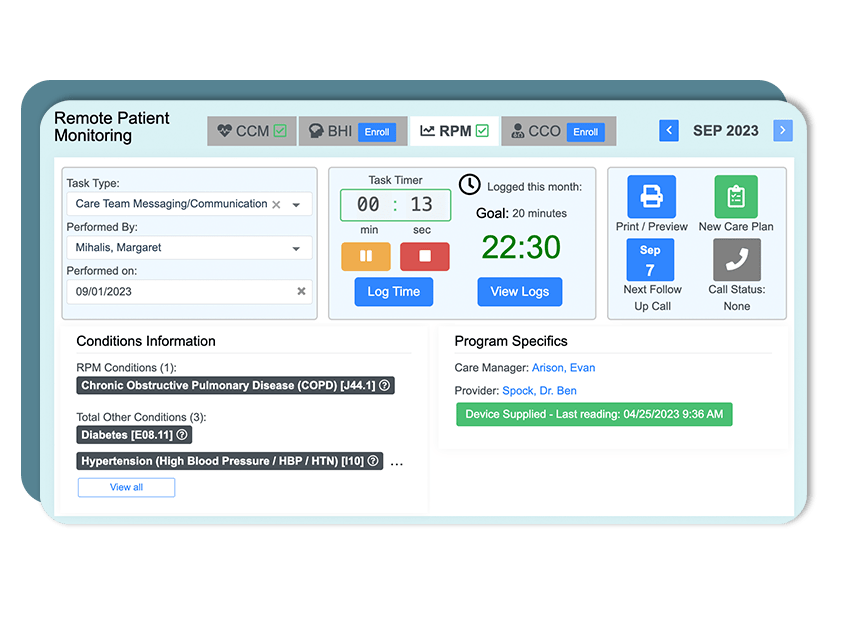Cutting-Edge RPM Software: Enhance Patient Results with Modern Technology
Cutting-Edge RPM Software: Enhance Patient Results with Modern Technology
Blog Article
The Future of Healthcare: Remote Person Keeping Track Of Simplified
As healthcare remains to evolve, one area that holds tremendous pledge is remote patient monitoring. The concept of simplifying this procedure via technological advancements is improving the means treatment is delivered and obtained. With a focus on improving individual end results and streamlining health care distribution, remote tracking is poised to revolutionize the industry. By exploring the advantages, technological developments, and future trends in this field, we can obtain valuable insights right into the transformative possibility of remote individual tracking.
Benefits of Remote Client Tracking
Remote person monitoring presents a wide variety of advantages for both health care suppliers and individuals alike. Furthermore, remote person monitoring improves the total quality of care by offering a more comprehensive and alternative sight of patients' wellness standing beyond standard in-person visits.
Moreover, remote patient monitoring can cause improved individual outcomes and contentment. Individuals can delight in the ease of getting care in the comfort of their own homes while still recognizing that their health and wellness is being very closely kept an eye on. This can cause increased individual interaction and adherence to treatment strategies, inevitably bring about much better health outcomes. Moreover, remote monitoring can lower the demand for constant healthcare facility brows through, lowering medical care costs for both service providers and patients. Overall, the advantages of remote individual monitoring are clear, making it an important device in contemporary health care distribution.
Innovation Driving Remote Tracking
In the world of modern health care, technical developments play a pivotal role in driving the development and performance of remote client monitoring. The combination of cutting-edge innovations such as wearable gadgets, mobile applications, and cloud-based systems has actually revolutionized the method health care suppliers remotely check and take care of patient health - remote patient monitoring platform. These technologies allow constant real-time surveillance of essential signs, drug adherence, and other critical health and wellness data, enabling timely interventions and individualized care plans
One key modern technology driving remote tracking is the Net of Points (IoT), which allows smooth connection between medical gadgets and health care systems. IoT devices such as smartwatches and wireless sensors transmit and collect person information to central systems, facilitating remote monitoring from throughout the globe. Expert system (AI) and artificial intelligence algorithms even more boost remote monitoring by analyzing huge quantities of patient data to identify patterns, forecast wellness patterns, and alert healthcare companies to potential concerns.
Effect on Healthcare Shipment
With the assimilation of advanced innovations driving remote patient surveillance, the influence on health care shipment is coming to be significantly extensive and transformative. Remote individual surveillance enables doctor to offer more tailored and positive like people, leading to improved health and wellness results and reduced hospital admissions. By remotely tracking crucial signs, these details signs and symptoms, and medication adherence, healthcare professionals can intervene early, avoiding difficulties and boosting the general high quality of treatment.
Furthermore, remote monitoring boosts accessibility to healthcare solutions, particularly for individuals in underserved or rural areas. Clients can obtain continual surveillance and support from their homes, getting rid of the need for frequent in-person sees. This not only conserves time and lowers expenses for both clients and healthcare facilities however likewise reduces the threat of exposure to transmittable diseases, an important consideration in the present healthcare landscape.
In addition, remote individual tracking makes it possible for healthcare suppliers to far better designate resources and focus on care based on real-time information. By recognizing high-risk clients and stepping in quickly, medical care delivery becomes more effective and reliable, ultimately leading to a more lasting and patient-centered medical care system.
Improving Client End Results

Moreover, RPM enables positive management of persistent problems, reducing the possibility of acute exacerbations and hospital readmissions. Clients take advantage of enhanced convenience and convenience, as they can get treatment in their own homes while staying my review here connected to their doctor. This constant surveillance not just improves patient satisfaction however likewise promotes blog here a feeling of empowerment and engagement in their very own health and wellness management.
Future Trends in Remote Surveillance
Accepting innovative modern technologies in remote client tracking is shaping the future landscape of health care distribution. One considerable fad is the boosted usage of wearable gadgets and sensors to gather real-time data, making it possible for healthcare providers to keep track of patients constantly without the requirement for constant in-person check outs.

Moreover, telehealth platforms are coming to be more advanced, enabling for digital appointments, remote medical diagnosis, and remote patient checking all in one integrated system (software for remote patient monitoring). This all natural technique to remote tracking is enhancing medical care delivery, improving patient complete satisfaction, and inevitably, boosting total top quality of care
Verdict
Finally, remote individual tracking uses numerous advantages in health care shipment, driven by innovations in innovation. It has the potential to enhance patient results and transform the method health care is provided. Future patterns in remote monitoring will proceed to shape the landscape of health care, giving chances for more customized and efficient person care.
Remote patient surveillance presents a wide range of advantages for both health care carriers and clients alike. Additionally, remote person surveillance improves the general high quality of treatment by giving a more thorough and all natural sight of clients' health and wellness standing beyond traditional in-person visits.
Moreover, remote patient tracking can lead to better individual outcomes and complete satisfaction. Remote patient surveillance enables healthcare companies to use more personalized and positive care to clients, leading to boosted wellness outcomes and decreased medical facility admissions. Remote client monitoring (RPM) plays a considerable function in improving individual results by providing continuous, real-time data that allows medical care carriers to intervene quickly and adjust therapy strategies as needed.
Report this page